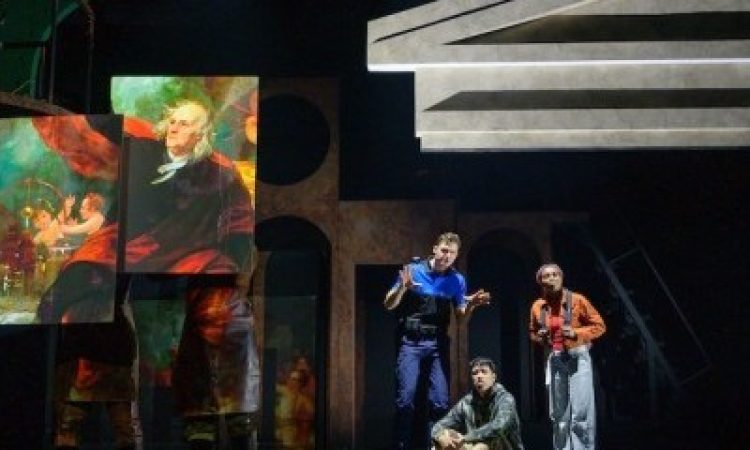I’m waiting outside the Plays and Players theater, waving at friends and chatting alongside others as we check our watches. It’s 7:18 pm, and we still haven’t been let in for a 7 pm show of Franklin’s Key by Pig Iron Theater. It’s a nice night out, though, and the warm sun adds to the buzz of anticipation. Soon, we hear it’s a technical issue – a funny happenstance at a show meant to uncover the secrets of science and history through brilliant technical theater work.
Luckily, we’re soon let in and the show starts at half after. As the lights dim, the chugging electric beats of Rosie Langabeer’s composition take over as three Gogglers – creatures that don’t speak yet have a physical language all of their own, light bare bulbs one by one, using only their hands, minds, and magic. Or is it bioether? We are introduced to Philadelphia teen siblings Temple (played by Jameko Monet Wilson) and Arturo (played by Alton Alburo), setting out to uncover exactly that. Too much bioether leads to bad things: mainly blackouts throughout the city. Temple and Arturo triangulate – or rather, rectangulate – these blackouts and discover a magical device (later named “pyre”) that allows Temple to adjust and manipulate the bioether that surrounds living things. Going after a woman connected to the Philadelphia Museum of Art leads to the two finding themselves inside a maze of tunnels underneath the city – and a fight for their lives.
Franklin’s Key seeks to delight and amaze. With illusions and pyrotechnics, light and shadow play a big part in illuminating many pressing questions that can speak to children (and adults!) today. Who can I trust? Where is my community? What does it mean to rely on others? The rich visual world by directors Dan Rothenberg and Robert Quillen Camp shines and awes. With costume design by Maiko Matsushima that’s subtle and lived-in, set design by Anna Kiraly that dominates the stage, video design by Dave Tennent and Joshua Higgason that provides moments of suspense and action, and props overseen by Peyton Smith, every moment onstage looks lush and layered. Evident in the visual language is a Lecoq and Viewpoints-influenced physical language (we are, quite literally, introduced to all of the characters in a Viewpoints exercise!) that moves most frequently through the bodies of the aforementioned Gogglers (Ben Grinberg, Makoto Hirano, and Devon Sinclair), who whisk and whir around stage as they move sets and provide illusionary effects.
Franklin’s Key is marketed as enjoyable from ages eight to eighty-eight, and is certainly sweet and sincere in its message. While definitely geared more towards kids in its writing, everyone will delight at the genius of the stage magic.
Franklin’s Key, Plays and Players (Philadelphia), June 5-29.






